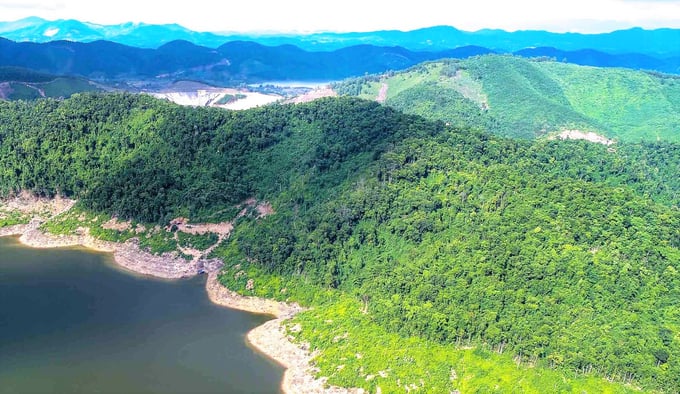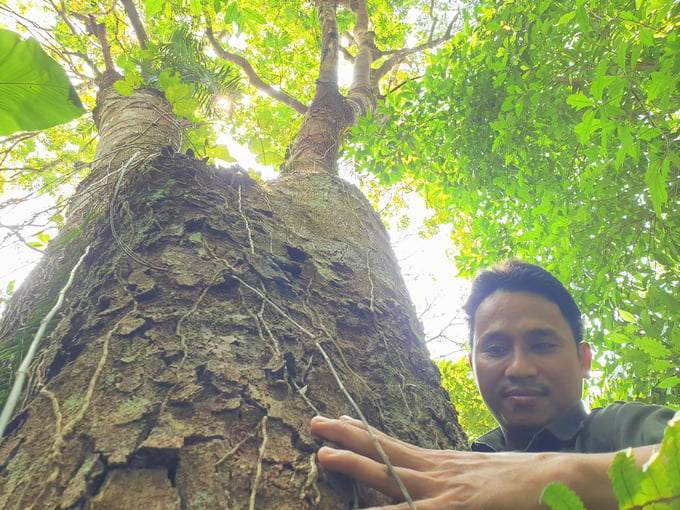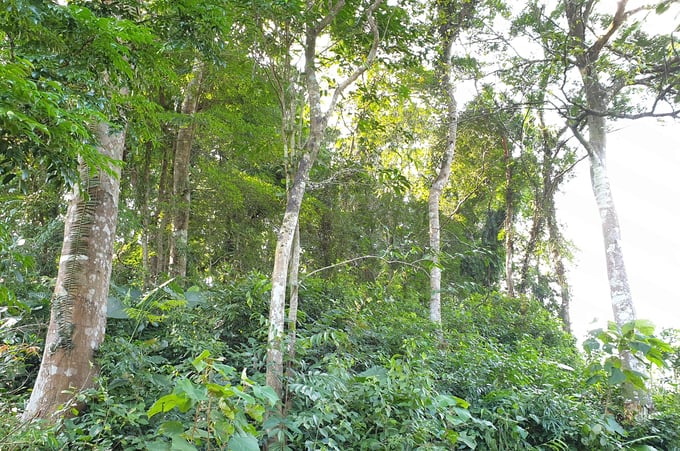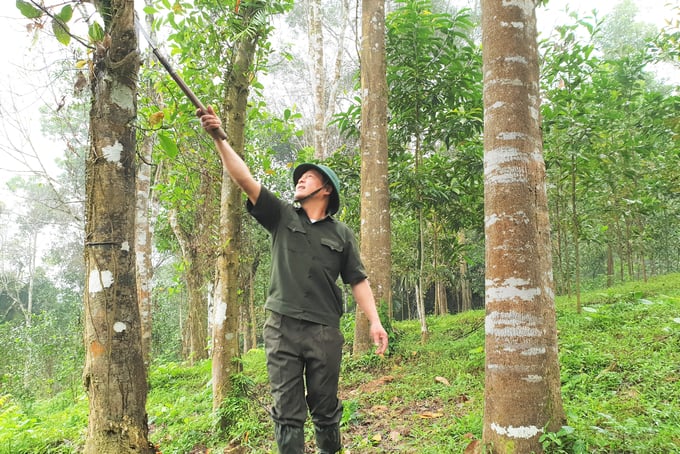May 17, 2025 | 10:01 GMT +7
May 17, 2025 | 10:01 GMT +7
Hotline: 0913.378.918
May 17, 2025 | 10:01 GMT +7
Hotline: 0913.378.918
Vietnam currently has over 10 million hectares of natural forest according to Decision No. 2860/QD-BNN-TCLN 2022 on the national forest status in 2021. This vast forest area is capable of carbon sequestration and storage, contributing to the reduction of greenhouse gas emissions as well as the fight against global climate change.

With over 217,000 hectares of natural forest, Ha Tinh is expected to sell 2 millions of carbon credits to international organizations, earning around USD 10 million annually. Photo: Thanh Nga.
The production and selling of carbon credits to international organizations is a positive but neglected global trend. The majority of the Vietnamese population is still unfamiliar with the concept of carbon credits.
In December 2022 the Government issued Decree 107/2022/ND-CP on the transfer of emission reduction results and the financial management of GHG emission reduction payment for 6 North Central provinces from Thanh Hoa to Thua Thien - Hue. This marks an important milestone and sets the foundation for carbon exploitation in Vietnam.
Moreover, effective utilization of carbon will yield a large amount of profit to increase income for people who depend on forestry including forest management, protection and development. It will promote sustainable forest management in accordance with Vietnamese regulations and the Forest Stewardship Council (FSC) standards.
According to experts, with more than 217 thousand hectares of natural forest, Ha Tinh can sell carbon credits to international organizations at a price of USD 5 per credit and earn up to 10 million USD annually. However, these figures are only estimations without official calculations or statistics. This shows that the forestry sector and forest owners themselves are uncertain about the examination of forest reserves to precisely determine the potential for carbon sequestration of the aforementioned forest area.

This vast potential will be a major asset for the protection and sustainable development of forests if exploited effectively. Photo: Thanh Nga.
Mr. Tran Trung Anh, Head of the Department of Science and Investment Cooperation under Huong Son Forestry and Service One Member Co., Ltd. has researched extensively into the process of selling forest carbon credits in Vietnam as well as other countries around the world. He concluded that Vietnam and Ha Tinh province in particular has great but untapped potential for carbon credit selling.
“According to preliminary calculation, the company can earn between 16 and 20 billion VND from the forest area under our management at a cost of 5 USD per carbon credit," assessed Mr. Anh.
Huong Son Forestry and Service Company is currently managing and protecting over 19 thousand hectares of natural forest in the three communes of Son Hong, Son Tay and Son Kim 1. The company's forests are categorized as evergreen broadleaf natural forests with a wood reserve of approximately 2 million cubic meters. The FSC has awarded the company with a certificate of sustainable forest management for its ecosystem services, including the conservation and absorption of forest carbon stocks under document No. GFA-FM/COC-002643. The company's carbon dioxide reservoir is estimated at nearly 4 million tons; capable of absorbing approximately 150 thousand tons of carbon dioxide annually.
“We can manage Vietnam's forests sustainably, increase forest capital, and aid in the global fight against climate change if we can fully realize the potential of the sale of forest carbon credits. This new resource will also reduce pressure on the state budget in terms of local forest protection," said Mr. Anh.
In 2004, Huong Son Forestry and Service Company began deploying its sustainable forest development program. By 2013, the company became the first forest owner in Ha Tinh province to be granted a certificate of sustainable forest management from the FSC on an area of 19,708 hectares, accounting for over 99% of the total forest area that the company was assigned to manage and protect.

According to experts, a forest's capacity to absorb and store carbon decreases with age. Photo: Thanh Nga.
According to Government's regulations at the time, the FSC forest certification acted as a logging permit. However, following the forest closing policy in 2014, the FSC certificate took on a greater purpose, namely the sustainable development of ecosystem services, including forest carbon credits.
During the 10-year journey of forest protection in accordance with FSC's regulations, the company has greatly reinforced the role of Ha Tinh forest as an extraordinarily valuable resource. The province currently houses nearly 70 hectares of IIB rehabilitation forest with rare wood species such as ironwood, ford, etc. With an average lifespan of 35 years, these trees have the potential to absorb large amounts of carbon.
In addition, this 19,000-hectare area of natural forest is capable of conserving biodiversity by preventing soil erosion, retaining water, minimizing flash floods, and so on. On the other hand, it can improve the livelihoods of surrounding people by enriching forests with native tree species such as ironwood, Bintangor, ford, etc. Additionally, nearly 100 hectares of medicinal plants were planted under the forest canopy in Son Kim 1 and Son Tay communes.
Vu Quang National Park is another forest owner with great potential for carbon sequestration in the province. This company is managing and protecting more than 50,000 hectares of natural forests. Most notably, the majority of the company's forest land is made up of young trees, which have exceptional capacity to absorb carbon.

Ha Tinh's forest owners have great expectations for the sale of carbon credits. Photo: Thanh Nga.
According to Mr. Thai Canh Toan, Deputy Director of Vu Quang National Park, the park's draft allocation plan estimates that the National Park will earn at least VND 10 billion from the sale of forest carbon credits.
“Resources from selling carbon credits will greatly reduce pressure on the budget allocated to forest protection and development. In the short term, this cash flow will pay for silvicultural activities such as forest enrichment, afforestation, etc., but not forest protection," emphasized Mr. Toan.
Translated by Nguyen Hai Long

(VAN) Cold-barn systems efficiently manage environmental and temperature conditions, which aids in the prevention of respiratory diseases in pigs and protects them from the vectors that transmit African swine fevers.

(VAN) To tackle challenges, the project 'Addressing key technical bottlenecks in the grouper supply chain in Vietnam' has been underway since 2024.

(VAN) The project 'Disease-Resilient and Sustainable Cassava Production Systems in the Mekong Region', funded by the Australian Center for International Agricultural Research (ACIAR), is being implemented from 2024 to 2028.

(VAN) Data from 10,000 farming households will help professionalize production organization and support the implementation of the One Million Hectares Program for High-Quality, Low-Emission Rice Cultivation.

(VAN) FAO Director-General QU Dongyu marks International Day of Plant Health at NENA conference.

(VAN) Deputy Minister of Agriculture and Environment Hoang Trung affirmed that floriculture and ornamental plants are a growing industry that receives significant global attention.

(VAN) The three staple crops dominating modern diets – corn, rice and wheat – are familiar to Americans. However, fourth place is held by a dark horse: cassava.